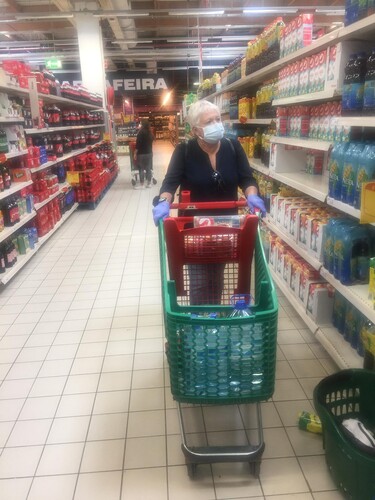Abstract
In this essay, we analyse pictures taken by participants of a research study on their daily lives during the initial lockdown period in Portugal, as the result of the emergence of the Covid-19 pandemic. Photographs have the power to freeze a moment in time that, despite being represented in two-dimensions, is multi-layered. These images reveal the profound impact of the pandemic on people’s lives, affecting the most basic elements of their existences, related to the organisation of time, the use of space and the maintenance of relationships. We argue that there is a ‘back to basics’ effect, not only in biographical terms but also sociologically, in the mobilisation of core concepts of the discipline to give depth and shape to the macro narratives (centred on numbers and trends) of the pandemic.
Picturing the extraordinary in the mundane
In early 2020 life changed abruptly in Europe. In Portugal, the first and most far-reaching lockdown due to the Covid-19 pandemic occurred almost immediately after the pandemic was declared by the World Health Organisation, in mid-March, in which working from home became compulsory, schools were shut down and leaving home premises became an exception in the organisation of life. This made a very common picture in the daily life of most countries, Portugal included. It conveys not only an aesthetic change in the way individuals present themselves and relate to others, but is also representative of the profound transformations that impacted the organisation of social life, in its most basic dimensions. In this simple photograph, we see a man wearing a mask with fogged lenses just before going to the supermarket. If we analyse it in context, we can see social change in motion: (1) a banal everyday task requires preparation, namely in terms of protection when in co-presence of other people; (2) the use of a mask, as an unusual practice (at least in Europe), requires adaptation, especially for those who wear glasses; (3) this ordinary task deserves to be photographed due to its exceptionality in the context of a lockdown; and (4) there is an underlying temporal dimension, a before and an after the pandemic, with the ordinary (in the before) becoming something extraordinary (in the after).
FIGURE 1. Going shopping (preparation before leaving the house), photograph by Guilherme Rodrigues (42, Higher education degree, designer), sent on 16 April 2020
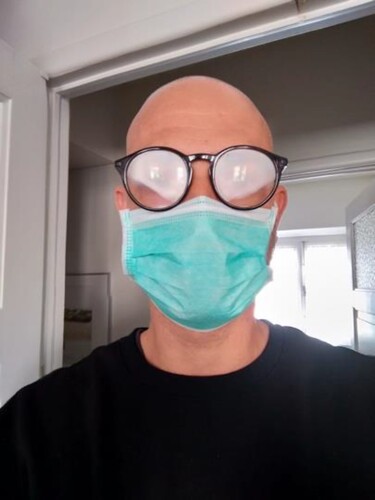
In an exploratory approach, aimed at understanding the configuration of these mundane changes, we developed spin-off research from the sociological project entitled ‘Biographical echoes: triangulation in the study of life histories’. The goal of the main project was to understand how a life can be reconstituted using not only autobiographical accounts but also hetero-biographical ones. With the emergence of the Covid-19 pandemic, the fieldwork was obviously suspended. We then decided to get back in touch with the study participants and, through short telephone interviews, exchange of SMS and, most of all, collection of photographs, understand how they were objectively and emotionally coping with the pandemic. We asked the participants to send us photographs that, having been taken during the first lockdown period in Portugal (which extended from March to May 2020), were significant to illustrate their daily lives or activities and the changes in their routines. We received, via WhatsApp, 210 images from 20 participants (out of the original 38), between April and June 2020, illustrating how they experienced these months of lockdown. Frequently, the photographs were sent with personal comments, brief reflections and short captions referring to the description of the moments portrayed. We were given recorded oral or written permission to use the pictures in research outputs and publications. All the participants, identified herein with pseudonyms, live in the Lisbon Metropolitan Area, most of them are women (13), aged between 42 and 73 years old, their educational levels range from the second cycle of basic education (4 years) to a higher education degree, and their occupations are socially diverse (for example, manicurist, accountant, teacher, clerk, educational assistant, designer or diamond cutter).
Of these 210 photographs, we only present 10 in this article. Although we intend to analyse the gender, age and class stratification underlying the whole set of photos (and thus examine the participants’ social characteristics and the impact in the pictures taken), for the purpose of this essay, we selected the images based on three different criteria that allowed us to theoretically and thematically cluster them and present them as representative of these clusters. These criteria were (i) the frequency of the type of photographs sent (for example, homemade food, bread very particularly, is one evident example of a recurrent topic illustrating how people took time to prepare slow meals in a way not done before); (ii) the atypicality of the moment, context, process or aspect; (iii) both our theoretical approach and the comments made by the participants on their own photographs were used to contextualise and thematically cluster the 210 photographs and to inform the selection of the 10 images presented here. Based on this overview of the type, meaning and frequency of the photos, we were able to confirm that these amateur, casual and mundane pictures (many times out of focus or cropped) were capable of representing important elements and dimensions of the daily lives and coping strategies of the participants during the Covid-19 pandemic. The significance and value of the collected images do not lie only in their visual relevance per se, but on their personal and sociological meanings.
We argue that the analysis of these photographs points to the centrality of time, space and relationships as three key dimensions that reveal how life during this first stage of the pandemic can be resumed and structured around the basic principles of social existence that are usually obscured by habit and routine.
Routine and disruption in the temporal organisation of daily life
When people were forced to stay at home in mid-March, in Portugal, to minimise the spread of the virus, there was an abrupt and unprecedent disruption of the way they organise their time. The break of routines and of what is usually taken-for-granted forced individuals to adjust not only their practices but also their mindsets, to a new reality. One of the main consequences of staying at home was that the time previously compartmentalised by life spheres overlapped into one single space. This adaptation process implied giving shape to new ways of arranging time and daily activities. In fact, the definition of new routines and habits plays a fundamental role in the establishment of ontological security and in giving order and coherence to the complex system of relationships, practices and contexts that structure social life.
In this sense, most of the photographs we received precisely picture routine tasks rather than unusual moments (as was once the main function of domestic photography): ordinary moments in extraordinary times. A large number of photographs illustrate the preparation of food: meals, cakes and even bread (). Individuals portray themselves doing household tasks (mostly women), such as cleaning or ironing (), which, for some, was previously done by a housemaid. There are also images of bricolage, house renovation and do-it-yourself (DIY) activities, like painting a room or restoring a piece of furniture (mostly men). Images of hygiene products are also common, as they became a central part of daily life ().
FIGURE 2. Making bread, photograph by Francisca Ascensão (47, 2nd cycle of basic education, city hall operational assistant), sent on 24 April 2020
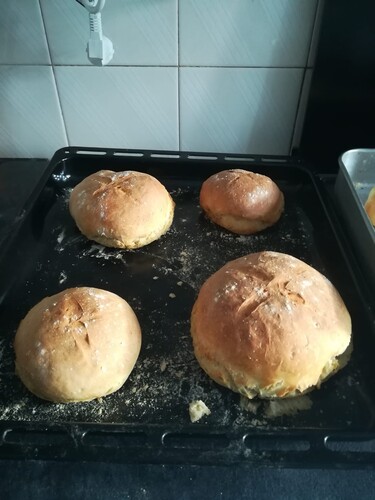
FIGURE 3. Ironing, photograph by Alice Rodrigues (72, Higher education degree, economist, retired), sent on 19 April 2020
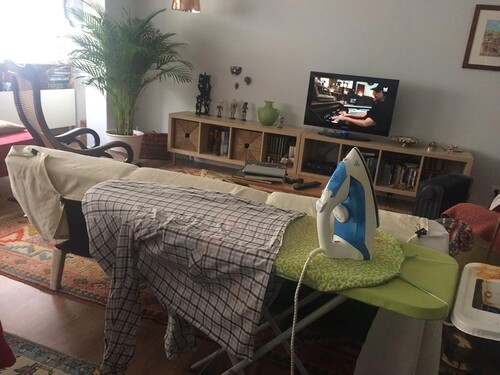
FIGURE 4. Hand sanitiser and disinfectant at a house entrance hall, photograph by Angelina Diogo (69, Higher education degree, kindergarten teacher, retired), sent on 19 April 2020

Tasks related to household chores and hygiene are not new in people’s lives. What is new is the visibility and centrality they assume in a changed social micro context. Basic, daily survival tasks related to food and cleaning, which usually have an invisible nature due to their repetitive character, have entered the realm of consciousness of individuals in a renewed way. This is especially the case for those who are retired and those working from home, with such tasks coming to the forestage of daily existence, at the very core of the organisation of their time. The focus on these mundane activities, which individuals can actually control, is an important social mechanism to provide an immediate sense of security and temporal continuity to their biographies when facing a disruptive period with no predictable end date and whose unfolding is directly beyond their control.
A changed sense of space
The pandemic has brought to the fore people's sense of space, and there has been much reflection on the spatial limitations or changes that Covid-19 has imposed. State-sanctioned lockdown(s), and the restriction of movement outside the home have transformed perceptions of the ‘inside’ or ‘outside’, the interior becoming starkly juxtaposed with the exterior. The interior being a haven, a spatial barrier against illness versus a now threatening external world contaminated by an invisible threat. The imperceptible dangers of the pandemic only become evident via new signs and symbols that signify attempts to manage the precariousness of the ‘outside’.
The need to control and contain the threats posed by the virus exterior to the home is illustrated by . Here the photographer, taking the picture from the security of her home, has captured two workers ‘cleansing’ the street in an attempt to make this outside world safer. Mass, large-scale sanitisation has become a key motif of the pandemic. Once taken for granted spaces now need to be decontaminated. There are two aspects of this image worth noting. First, both workers are wearing personal protective equipment. Full body suits and gloves are visible and signal to onlookers that the work is dangerous and that those doing the work need to be protected. Second is the distancing between the two workers in the image. They pose a threat to each other just as much as the unseen viruses they are trying to eradicate pose to others.
FIGURE 5. Street cleaning, photograph by Alice Rodrigues (72, Higher education degree, economist, retired), sent on 02 May 2020
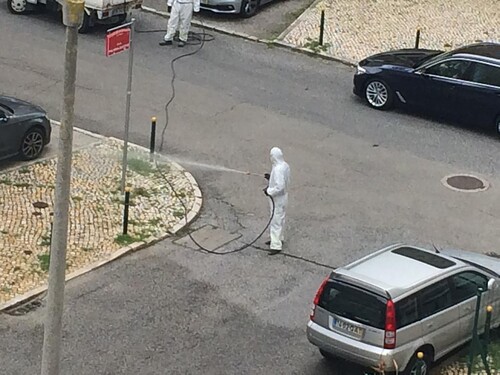
exemplifies the threat the external space poses for ourselves and others. An everyday act of sitting, possibly conversing with others, both familiar and strange, now signalled as off-limits and as dangerous. The image also points to how the pandemic has changed our movements through space. There is no time to idle, to sit or chat. Instead, people are encouraged to move on as quickly as possible, strategically adapting their behaviour to minimise their time outside and the potential dangers associated with meeting others. These changes are a challenge to the politeness codes, the rhythms of walking and the trips to places that are a core aspect of everyday life. These perceived hazards suggest that the way we engage with the environment or use external space for leisure and well-being are no longer benign but activities which need to be negotiated with care.
FIGURE 6. Public park bench, photograph by Márcia Aguiar (69, Higher education degree, teacher, retired), sent on 02 May 2020
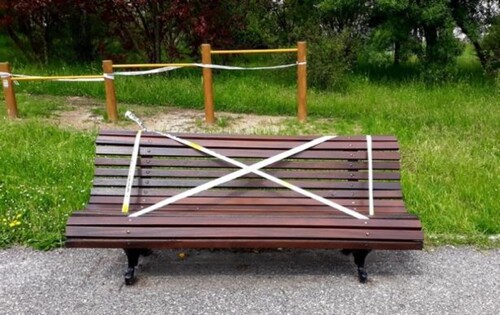
Shopping has come to typify this need to negotiate external space carefully. These spaces of consumption and choice cease to be convenient and now, instead, are places of regulated and orderly practice. This includes social distancing, queues for entry, one-way travel systems around the shops, limits on the purchasing of certain goods (especially in the early lockdowns) and the requirements for personal protective equipment. shows the shopper at a distance from other shoppers wearing both a surgical mask and surgical gloves. Wearing a mask to shop is indicative of how our ‘ways of operating’, or our many everyday practices, have been adapted and modified.
Alone together
While there is some evidence (anecdotal and otherwise) to suggest that the global pandemic had a significant impact on personal relationships, such as increases in divorce rates, decline in marriage rates, domestic violence and changes in cohabiting patterns (see, for example, Sifat Citation2020; Donagh Citation2020; Manning and Payne Citation2020; Guetto, Vignoli, and Bazzani Citation2020), for our respondents, there is little evidence to suggest their relationships ended abruptly or catastrophically with the lockdown(s) but, instead, they were transformed. People adapted, behaviours became adjusted, feelings lingered, and relationships endured their context. Yet, the pandemic and especially the lockdown(s) places this ‘strategic adaptation’, agency and endurance under a new light or sociological lens, even if these aspects of human and inter-personal interactions are linked to the very core of society and sociology. The biggest challenge people face is the difficult balance between the need to maintain physical distance and be apart from others, while simultaneously nurturing emotional proximity to loved ones and connecting to a large number of people around the world also experiencing the Covid-19 pandemic.
illustrates the desire felt in the households to have a public say on how people are feeling and on their attitude towards what is happening. They are ok, and they are hopeful. At the same time, they would like the world to know. They also want to be part of the collective movement, all around the world, of displaying rainbows in the windows of houses as a sign of hope. They are ‘alone together’. The analysis of relationships in this context is not merely an opposition between we (representing security) and them (as the external menace). The ‘others’ are facing the pandemic as well. This drawing became ‘viral’ and so did, at one point, the hope to connect the lockdown and private feelings with the public and collective spheres.
FIGURE 8. Painting a rainbow, photograph by Adriana Roque (37, secondary education, clerk), sent on 27 April 2020
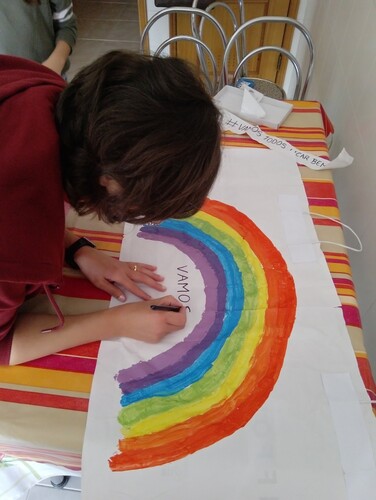
Given the impossibility of being, at least as regularly and under the same conditions as before, with family and friends, the way people relate with each other and connect at the emotional level changed abruptly. is a picture taken by a grandmother of her granddaughter. Two relevant elements stand out in this image. First, the distance at which the photo is taken. Second, the yard as an extension of the security provided by the house. Both testify the adaptation processes at play in the way families interact. Not being able to touch, being physically close and going for a walk outside as a family are not synonymous of emotional distance or of loosening ties. The maintenance of contact is done creatively and using the available means, even if under strict structural constraints, with agential capabilities playing an important role in the definition of alternative strategies for interaction. There is a clear strategic adaptation in finding alternative ways to maintain relational proximity.
FIGURE 9. Child playing in the yard, photograph by Luísa Botelho (57, 3rd cycle of basic education, kindergarten teacher assistant), sent on 18 April 2020
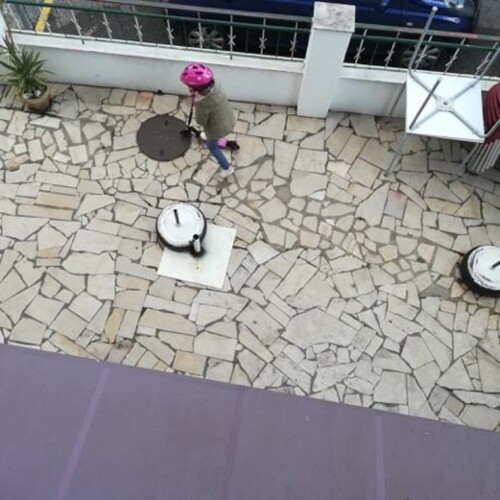
Work relationships have also changed with the expansion of telework. Work meetings, occurring from home, started entailing an unprecedent private context. Print screens, as the one displayed in , became common as illustrations of this privatisation of work relations. All of a sudden, despite the mediated contact (and especially because of that) the plurality of work colleagues’ lives now assumes a new visibility in the interaction contexts. Their family environments and challenges (more stressful under lockdown), as well as their living conditions, have entered people’s field of vision. These pictures do not simply record work meetings. They picture and frame the usually invisible family–work conciliation strategies.
The life behind the grand narratives of the pandemic
While governments talk of ‘trends’ and big numbers, the real impact of the pandemic can only be fully revealed by looking closely at biographies. Individual experiences add depth and context to the grand macro narratives. Big numbers are meaningless if we are not able to understand the impact on people. This is exactly what Mills highlights as the intersections of history and biography. Through the photographs we received and analysed, we are able to see the arc of history played out in people’s lives.
These images also testify how a major macro event consubstantiates an inclination towards the basic at two different levels. First, in biographical terms, concerning the role that the usually latent physical, biological and ontological dimensions of existence play in the structuration of daily life and of mindset. And, second, at the sociological level, regarding the renewed importance that core concepts of sociology, such as time, space and relationships assume in this analysis, instead of developing new analytical models and notions to account for what is happening in the world.
Disclosure statement
No potential conflict of interest was reported by the author(s).
Additional information
Funding
Notes on contributors
Ana Caetano
Ana Caetano is a researcher at the Centre for Research and Studies in Sociology (CIES-Iscte) and an assistant professor in the Department of Social Research Methods of the School of Sociology and Public Policy at Iscte-University Institute of Lisbon. Her main research interests are biographical disruptions, personal reflexivity, the structure–agency relation and biographical methods. Currently, she co-coordinates the project ‘Biographical echoes: triangulation in study of life histories’ and she is also part of the project ‘Linked lives: a mixed multilevel longitudinal approach to family life course’, both funded by the Portuguese Foundation for Science and Technology (FCT).
John Goodwin
John Goodwin is a Professor of Sociology and Sociological Practice in the School of Media, Communication and Sociology at the University of Leicester. As a sociologist, John has a broad range of research interests including education to work transitions, sociological research methods and the history of sociology. He is a recognised expert on the life and sociology of Pearl Jephcott and he also has a significant interest in the works of Norbert Elias and C Wright Mills. In terms of his sociological practice, John has expertise in qualitative secondary analysis, restudies, biographical methods and the use of unconventional data sources in sociological research.
Magda Nico
Magda Nico is a sociologist. She is a researcher at the Centre for Research and Studies in Sociology (CIES-Iscte) and an assistant professor in the Department of Social Research Methods of the School of Sociology and Public Policy at Iscte-University Institute of Lisbon. She currently coordinates the project ‘Linked Lives: a multilevel, longitudinal and mixed approach to family Life Course’ and co-coordinates the ‘Biographical echoes: triangulation in study of life histories’ with Ana Caetano, where she practices her interests in life course methods and theory, trajectories and biographies, families and relationships, and in long-term processes, such as precarity and inequalities.
Anabela Pereira
Anabela Pereira is a researcher at the Centre for Research and Studies in Sociology (CIES-Iscte), where she is a part of the research team of the project ‘Biographical echoes: triangulation in the study of life histories’. She received her PhD in sociology from University Institute of Lisbon in 2013, and she is currently a master’s student of Cognitive Science at the University of Lisbon. Her main research interests are trajectories and identities, reflexivity, embodiment and the sociological methods of research. She also has an interest in visual culture, perception and cognition.
REFERENCES
- Donagh, B. 2020. “From Unnoticed to Invisible: The Impact of COVID-19 on Children and Young People Experiencing Domestic Violence and Abuse.” Child Abuse Review 29: 387–391.
- Guetto, Raffaele, D. Vignoli, and G. Bazzani. 2021. “Marriage and Cohabitation Under Uncertainty: The Role of Narratives of the Future During the COVID-19 Pandemic.” European Societies 23 (sup1): S674–S688. doi: 10.1080/14616696.2020.1833359.
- Manning, W. D., and K. K. Payne. 2021. “Marriage and Divorce Decline During the COVID-19 Pandemic: A Case Study of Five States.” Socius 7: 237802312110069. doi:10.1177/23780231211006976.
- Sifat, R. I. 2020. “Impact of the COVID-19 Pandemic on Domestic Violence in Bangladesh.” Asian Journal of Psychiatry 53: 102393. doi:10.1016/j.ajp.2020.102393.

